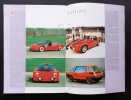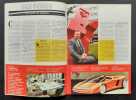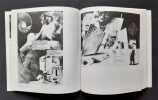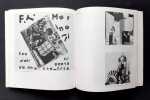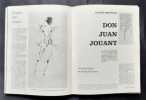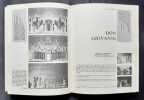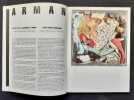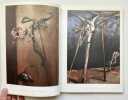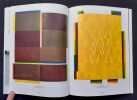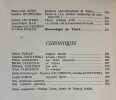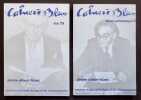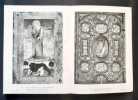2811 books for « giovanni »Edit
-
Type
Book (2738)
Engraving (3)
Magazine (3)
Maps (51)
Music sheets (13)
New book (2)
Photographs (1)
-
Latest
Last 24h (2)
Last 3 days (1)
Last month (92)
Last week (4)
-
Language
Dutch (1)
English (2)
French (2758)
German (1)
Italian (37)
Latin (4)
Russian (8)
-
Century
16th (82)
17th (67)
18th (123)
19th (195)
20th (1190)
21st (153)
-
Countries
Belgium (233)
Brazil (2)
Canada (16)
Denmark (17)
France (1841)
Germany (8)
Greece (3)
Italy (324)
Netherlands (1)
Switzerland (344)
United Kingdom (14)
United States of America (8)
-
Syndicate
ALAC (16)
CLAM (14)
CLAQ (9)
CNE (2)
ILAB (1343)
NVVA (53)
SLACES (53)
SLAM (942)
SNCAO (1)
Topics
- 1900 (54)
- Archaeology (30)
- Architecture (35)
- Astronomy (7)
- Belgium (7)
- Biography (22)
- Boccaccio (131)
- Bofa gus (15)
- Brunelleschi (7)
- Cartomancy (18)
- Casanova knight (9)
- Caselli giovanni (10)
- Catholicism (13)
- Ceramic (6)
- Children’s books (10)
- Christ (the) (9)
- Christianity (12)
- Cinema (12)
- Civilisation (13)
- Comic strip (10)
- Detective novels (28)
- Dotoli giovanni (6)
- Drawings (6)
- Early printed books (20)
- Economics (9)
- Engraving (books about) (9)
- Entomology (12)
- Erotic (10)
- Ethic (7)
- Europe (29)
- Fine arts (55)
- First edition (41)
- Flora (8)
- Franco (8)
- Futurism (23)
- Geography (21)
- Germanic languages (13)
- Greece (25)
- Guareschi giovanni (68)
- Guide books (10)
- Helvética (21)
- History (123)
- Illustrated books (10)
- Industrial arts & crafts - fine arts (21)
- Italian (203)
- Italian literature (38)
- Italy (207)
- Latin (22)
- Law (20)
- Lista giovanni (10)
- Literature (184)
- Liturgy (7)
- Lorenzo (7)
- Maps (56)
- Medicine (35)
- Middle ages (9)
- Music (18)
- Painting (19)
- Palaeography (6)
- Papini giovanni (67)
- Paris (8)
- Perrault charles (6)
- Philology (22)
- Philosophy (57)
- Photography (13)
- Poetry (47)
- Policy (12)
- Psychology (8)
- Ptolemy (13)
- Religions (75)
- Reverend (24)
- Review (26)
- Rome (25)
- Sciences (15)
- Scores (41)
- Sculpture (15)
- Simone (6)
- Sociology (10)
- Songs (12)
- Switzerland (25)
- Symbolism (8)
- Tales (16)
- Tea (6)
- Technology (27)
- Theatre (19)
- Theology (33)
- Translation (10)
- Travel (11)
- Turkey - ottoman empire (8)
- Various (10)
- Vatican city (6)
- Venice (13)
- War (10)
- Western (6)
PININFARINA (Battista et Sergio). BERTONE (Giuseppe et Giovanni). GIUGIARO (Giorgetto). GANDINI (Marcello). MICHELOTTI (Giovanni).
Reference : 46635
Carton d'invitation + dossier de presse complet de l’exposition Design automobile, Les maîtres de la carrosserie italienne au Centre de création industrielle du Centre Georges Pompidou à Paris du 1er février au 30 avril 1990.
Dossier de presse sous chemise imprimée comportant une luxueuse brochure agrafée (21x30cm) de 32 pages en couleurs + carton d'invitation (21x15cm) en quatre volets + 15 pages de dossier de presse imprimées au recto seul + numéro spécial de l'hebdomadaire Le Point: 20 pages illustrées en couleurs autour de l’exposition et du design italien. Ensemble en très bon état.
La première partie de l’exposition, chronologique, retrace l’évolution de la carrosserie italienne de la deuxième moitié du XIXe siècle à nos jours. La deuxième partie de l’exposition, monographique, est consacrée aux quatre protagonistes de la carrosserie italienne : Pininfarina, Bertone, Giugiaro et Michelotti, qui ont collaboré avec les principales firmes européennes. Les douze prototypes ont été exposés, tous des pièces uniques.
Photographie futuriste italienne 1911-1939.
Prologue de Giovanni Lista. Paris : catalogue de l'exposition présentée au Musée d'Art Moderne d'octobre à janvier 1982. Un volume broché (21,5x24 cm), 159 pages. 144 photographies en noir avec les notices biographiques des artistes exposés. Bon état.
BATAILLE (Georges) - LISTA (Giovanni) - APOLLINAIRE (Guillaume) - TRAKL (Georg) - BLOK (Alexandre) - POUCHKINE - BORDERIE (Roger) - RONSE (Henri) - PERROS (Georges) - BUTOR (Michel) - OBLIQUES -
Reference : 28507
Don Juan - Analyse d'un mythe, tomes 1 et 2 -
Paris : Roger Borderie (Obliques, revue trimestrielle de littérature et de théâtre), 1974 - 2 volumes 21x27cm broché sous couvertures illustrées, 160 et 160 pages illustrées de plus de 160 reproductions de photos et dessins en noir dans et hors texte, pour une soixantaine d'essais et de textes - bon état -
Bibliographie, filmographie, mythologie, Le Dom Juan de Molière, Le Don Giovanni de Mozart, Georges Bataille, etc.
ROCHEFORT (Christiane) - GIOVANNI (José) - LEGUEBE (Eric) - ENDREBE (Maurice-Bernard) - STERNBERG (Jacques) - DOUCHET (Jean) - DAMASE (Jacques) - FELS (Florent) - CHRIST (Yvan) - LAURENT (Jacques) - PARINAUD (André) - collectif - ARTS (revue) -
Reference : 34430
Arts - Lettres spectacles - N°732 du 22 au 28 juillet 1959 -
Paris : Arts, 1959 - journal grand format en feuilles (42,8x69,5 cm), 12 pages abondamment illustrées - exemplaire plié en deux sans atteinte au texte - bon état général -
Au sommaire de ce numéro, Christiane Rochefort (Le tour de Paris en touriste), José Giovanni (Le policier un mauvais genre qui n'existe pas), Eric Leguebe (Le vrai visage de Don Quichotte est celui d'Ignace de Loyola), Maurice-Bernard Endrèbe (La bourse et la vie des romans policiers), la caricature en 8 leçons (II: les véhicules), Jean Douchet (une année de cinéma et une nouvelle vague), Florent Fels (Monticelli), Yvan Christ, Jacques Sternberg, etc.Fondée en 1952, animée par Louis Pauwels, André Parinaud et Jacques Laurent, la revue Arts a notamment ouvert ses pages à une large diversité d'écrivains. Arts est sans doute l'hebdomadaire qui rend le mieux compte de la vie intellectuelle française des années 1950 et 1960 (Arts a cessé de paraître en 1966).
IL DECAMERONE DI GIOVANNI BOCCACCIO TONNO 1.
Londra, Si trouva in Parigi aprresso Marcello Prault, 1768; in 16, 490 pp., cartonnage de l'éditeur. Plein veau en superbe état dos bien orné tomo 1 solo - tome 1 seul - en Italien - frontispice de Moreau.
Plein veau en superbe état dos bien orné tomo 1 solo - tome 1 seul - en Italien - frontispice de Moreau.
TELEMAQUE (Hervé). FROMANGER (Gérard). DEBECQUE-MICHEL (Laurence). GASSIOT-TALABOT (Gérald). LEMAIRE (Gérard-Georges). CHALUMEAU (Jean-Luc). JOPPOLO (Giovanni). BORY (Jean-François).
Reference : 47542
Opus International, n°128, été 1992. Hervé Télémaque.
Paris, directeur Georges Fall. Un volume broché 29x21,8cm, de 70 pages sur papier fort couché, illustrées en noir et en couleurs. Comprend un dossier Hervé Télémaque (25 pages). Très bon état.
Excellente revue d'art contemporain créée et dirigée par Georges Fall de 1967 à 1995.
ARMAN. DEBECQUE-MICHEL (Laurence). GASSIOT-TALABOT (Gérald). LEMAIRE (Gérard-Georges). CHALUMEAU (Jean-Luc). JOPPOLO (Giovanni). RESTANY (Pierre). HAHN (Otto). LAMARCHE-VADEL (Bernard).
Reference : 47543
Opus International, n°116, novembre-décembre 1989. Arman.
Paris, directeur Georges Fall. Un volume broché 29x21,8cm, de 72 pages sur papier fort couché, illustrées en noir et en couleurs. Comprend un dossier Arman (25 pages). Très bon état.
Excellente revue d'art contemporain créée et dirigée par Georges Fall de 1967 à 1995.
ADAMI (Valerio). JOUFFROY (Alain). LEMAIRE (Gérard-Georges). CHALUMEAU (Jean-Luc). JOPPOLO (Giovanni). DEBECQUE-MICHEL (Laurence).
Reference : 47544
Opus International, n°117, janvier-février 1990. Adami
Paris, directeur Georges Fall. Un volume broché 29x21,8cm, de 80 pages sur papier fort couché, illustrées en noir et en couleurs. Comprend un dossier Adami (23 pages). Très bon état.
Excellente revue d'art contemporain créée et dirigée par Georges Fall de 1967 à 1995.
VELICKOVIC (Vladimir). VELTER (André). GASSIOT-TALABOT (Gérald). CUECO (Henri). AVILA (Alin). LEMAIRE (Gérard-Georges). JOPPOLO (Giovanni). DEBECQUE-MICHEL (Laurence).
Reference : 47545
Opus International, n°121, septembre-octobre 1990. Velickovic.
Paris, directeur Georges Fall. Un volume broché 29x21,8cm, de 80 pages sur papier fort couché, illustrées en noir et en couleurs. Comprend un dossier Velickovic (30 pages). Très bon état.
Excellente revue d'art contemporain créée et dirigée par Georges Fall de 1967 à 1995.
BOUILLON (François). JOPPOLO (Giovanni). SEISSER(Jean). RIGHI (François). LEMAIRE (Gérard-Georges). DEBECQUE-MICHEL (Laurence). CHALUMEAU (Jean-Luc).
Reference : 47547
Opus International, n°126, automne 1991.
Paris, directrice : Marie-Odile Van Caeneghem. Un volume broché 29x21,8cm, de 72 pages sur papier fort couché, illustrées en noir et en couleurs. Comprend un dossier sur François Bouillon (27 pages). Très bon état.
Excellente revue d'art contemporain créée et dirigée par Georges Fall de 1967 à 1995.
JOPPOLO (Giovanni). LEMAIRE (Gérard-Georges). DEBECQUE-MICHEL (Laurence). CHALUMEAU (Jean-Luc). GASSIOT-TALABOT (Gérald). BORY (Jean-François). VAN CAENEGHEM (Marie-Odile). CREMONINI (Leonardo).
Reference : 47548
Opus International, n°127, hiver 1992. L'art au nom de quoi ?
Paris, directrice : Marie-Odile Van Caeneghem. Un volume broché 29x21,8cm, de 72 pages sur papier fort couché, illustrées en noir et en couleurs. Comprend un dossier L'art, au nom de quoi ? (20 pages). Très bon état.
Excellente revue d'art contemporain créée et dirigée par Georges Fall de 1967 à 1995.
TZARA (Tristan). SOUPAULT (Philippe). BEHAR (Henri). FAUCHEREAU (Serge). ROUSSELOT (Jean). VITRAC (Roger). LISTA (Giovanni). SCHWARZ (Arturo). ARAGON (Louis). CAWS (Mary-Ann). BROWNING (Gordon).
Reference : 46246
Tristan Tzara. Europe, revue littéraire mensuelle, n°555-556, juillet-août 1975.
Paris, directeur : Pierre Abraham. Un volume (13x21,5cm) broché, 280 pages avec une double page de fac-similé. Exemplaire en bon état. 240 pages sont consacrées à Tristan Tzara avec plusieurs textes inédits : un chapitre de Personnage d'Insomnie, deux conférences : Sur une exposition dada (1958) et Alfred Jarry (1931), six poèmes écrits après 1945, un extrait de l'étude sur La signification anagrammatique du Lais.
La poésie érotique féminine française contemporaine. Anthologie.
Paris : Editions Hermann, 2011. Un fort volume broché (15x22 cm), 581 pages. Index des auteures et des titres. Bon état.
L'histoire de la vie FOSSILES témoins de 4 milliards d'années.
Paris, Hatier, 1983; in-4, 216 pp., cartonnage d'éditeur avec jaquette. Bon état.
Bon état.
Présence de F.T. Marinetti. Actes du colloque international tenu à l'UNESCO.
Lausanne : L'Âge d'homme, 1982. Un volume 15,4x23,8cm broché de 394 pages. déchirure de 2cm en couverture sinon bon état.
CLAUDEL (Paul) - BERNANOS (Georges) - PAPINI (Giovanni) - MOREL (Robert) - HOOG (Armand) - DE LA TOUR DU PIN -
Reference : 44981
Les Pléiades. Carte du ciel. Premier cahier de poésie.
Paris : Editions Plon (Collection "Carte du ciel"), 1945. Directeur : Daniel Rops. Un volume broché (16,5x25,5 cm) sous couverture rempliée, 175 pages. Couverture et page de titre illustrés, lettrines et 11 bandeaux extraits de la Bible de Jacob Kerver. Tirage à 1400 exemplaires sur papier "surfine" des papeteries Johannot. Bon état.
ALBERT-BIROT (Pierre). FOLLAIN (Jean). LABRUSSE (Hugues). PONS (Max). ROUDAUT (Jean). SAINT-ROBERT (Philippe de ). LABORDE (Denise). DAGUET (Dominique). LISTA (Giovanni). FELLER (Paul).
Reference : 44740
Pierre-Albert Birot I et II. Cahiers bleus: n°14 et 15, hiver-printemps-été 1979.
Troyes: Centre Culturel Thibaud de Champagne. Directeur: Dominique Daguet. Deux volumes brochés (21x29,4 cm), 134 et 125 pages. Deux numéros principalement consacrés à Albert Birot. Bon état.
Créés en 1975 à Troyes par Dominique Daguet (1938-2021), poète et ancien secrétaire de Jean Paulhan, Cahiers bleus compteront 70 numéros jusqu’en 2007. Revue de poésie et de littérature qui propose des numéros thématiques et des monographies d’auteurs.
Concertino pour grenouilles -
Traduction de l'italien par Jeanclaude Berger avec le texte italien en regard - Genève : La Dogana (collection "poésie"), 2005 - un volume 16,3x21,2cm broché sous couverture à rabats, de 100 pages - Edition originale de la traduction tirée à 720 exemplaires - très bon état -
FELICE OLIVIERI SANGIACOMO (Laura de) - SALMI (Mario) - ARCAMONE BARLETTA (Cristina) - MUZZIOLI (Giovanni) - FRATTAROLO (Lorenzo) -
Reference : 42869
Trésors des bibliothèques d'Italie - IVe - XVIe siècles -
Avant-propos de Julien Cain et de Guido Arcamone - Paris : Bibliothèque nationale, 1950 - un volume 15,5x20,5cm broché sous couverture illustrée. 468 notices suivies de 24 planches hors texte en noir - bon état -
Les Malavoglia.
Paris, Club bibliophile de france, 1957; in-8, 257 pp., cartonnage de l'éditeur.
.
Les fossiles invertébrés.
Paris, Editions atlas, 1976; in-4, 128 pp., cartonnage de l'éditeur. Avec jaquette (BON ÉTAT ) mais jaquette abimée.
Avec jaquette (BON ÉTAT ) mais jaquette abimée.
Tizian.
Leipzig, Johannes asmus verlag, 1941; in-8, 168 pp., cartonnage d'éditeur. EN ALLEMAND - Avec jaquette (manque morceau en haut a gauche ).
EN ALLEMAND - Avec jaquette (manque morceau en haut a gauche ).
Giodano Bruno -
Traduit de l'italien par Walter Aygaud - Paris : Les Belles lettres (Collection Giodano Bruno), 2007 - un volume 13x19,2cm broché sous couverture à rabats de 115 pages - bon état -
Mon petit monde à Moi.
Paris, Serie gaie hachette, 1952; in-12, 254 pp., br. Très bon état avec une jaquette comme neuf.
Très bon état avec une jaquette comme neuf.
 Write to the booksellers
Write to the booksellers
